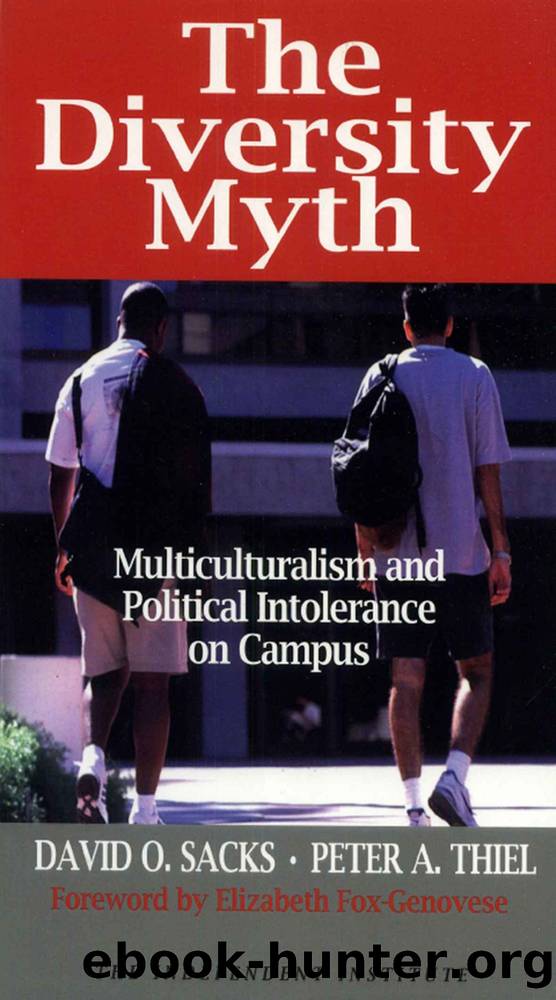The Diversity Myth by David O. Sacks & Peter A. Thiel

Author:David O. Sacks & Peter A. Thiel [Sacks, David O. & Thiel, Peter A.]
Language: eng
Format: epub
ISBN: 9780945999423
Publisher: Independent Institute
Published: 1999-01-01T05:00:00+00:00
Creating Difference
In late September of each year, 1,500 eager freshmen descend upon Stanford for a five-day âFreshman Orientation,â to be introduced to their classmates and to campus life more generally, and to find their place in the new community. Before the freshmen arrive, their respective RFs and RAs have already memorized their names and photographs. They are greeted with balloons and screams, promptly handed schedules with long lists of orientation activities, and instructed to participate in a series of icebreaker games. After dinner, the Leland Stanford Junior University Marching Band careens through the dorms, announcing itself with a boisterous cacophony of blasting trumpets and drumbeats. The freshmen do not hesitate to join the band's raucous rally, and begin what will be the first of many celebrations.
But âthe Farmâ (as Stanford is known to undergraduates) is not always the Norman Rockwell image of rustic beneficence. Orientation also is the first stage on which the multicultural dramas of oppression are acted out, and in this sense these first few days well prepare freshmen for some of the trials and tribulations of their next four years.2 The tone grows particularly serious when orientation leaders turn to diversity âprogramming.â A process of differentiation begins with special events for minority students, sponsored by the Asian American New Student Orientation Committee, the Black Recruitment and Orientation Committee, the Chicano/Latino Orientation Committee, and the Native American Orientation Committee. Minority freshmen are invited to attend a variety of receptions, banquets, organizational meetings, beach trips, and panel discussions on âminority issues.â3 These logistical differences in activities soon lead to real barriers, as students become friends with other students from their particular groups. Within several weeks, many dining hall tables become self-segregated, as students eat their meals with others they have come to know from the same race.
What begins as a number of receptions and programs to make minorities feel welcome at Stanford quickly separates the freshman class along racial lines. âWithin my first ten minutes at Stanford, I began to see the University dividing itself into separate groups,â remarked freshmen Benji Jenkins, upon observing in 1989 that exclusive signs such as âWelcome Blackâ helped to segregate minority students from other freshmen.4 Orientation's emphasis on differences can sometimes be so overpowering as to disorient new students. Recalling one such experience, freshman Brady Mickelson described âFaces of the Community,â an orientation program designed to introduce the 1993 freshman class to Stanford's âdiverseâ student population:
Professor James Adams, head of the VTSS CIV track, led us on a literal safari. He prefaced his remarks with the comment that âorientation is designed to disorient you.â Then the fun began. Dividing us into groups by last names, he asked that we assume the voice of an animalâG through L, an ape; M through S, a seal, etc. Then, on his cue, we made our animal's sound at the top of our lungs. The resulting cacophony was likened to our lives as members of the Stanford community: âBy the time you leave Stanford, you should be completely disoriented,â declared Adams.
Download
This site does not store any files on its server. We only index and link to content provided by other sites. Please contact the content providers to delete copyright contents if any and email us, we'll remove relevant links or contents immediately.
The Diversity Myth by David O. Sacks & Peter A. Thiel(101)
The Mothers: The Matriarchal Theory of Social Origins by Robert Briffault(57)
Indian Africa: Minorities of Indian-Pakistani Origin in Eastern Africa by Michel Adam(47)
Patriarchal Precedents: Sexuality and Social Relations by Rosalind Coward(45)
Homeless People by Unknown(42)
Suburban Environment - Sweden and United States by David Popenoe(40)
The Third Republic Defended: Bourgeois Reform in France, 1880 - 1914 by Sanford Elwitt(32)
